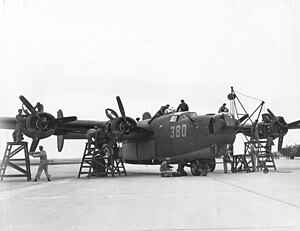|
829th Bombardment Squadron
The 829th Bombardment Squadron was a squadron of the United States Army Air Forces. It was active during World War II in the Mediterranean Theater of Operations as a Consolidated B-24 Liberator unit, where it earned a Distinguished Unit Citation. Following V-E Day, the squadron returned to the United States and began training with the Boeing B-29 Superfortress at Smoky Hill Army Air Field, Kansas, before inactivating in August 1946. HistoryThe squadron was activated at Fairmont Army Air Field, Nebraska as one of the four that made up the 485th Bombardment Group. It trained with Consolidated B-24 Liberators until March 1944, when it deployed to the Mediterranean Theater of Operations in March 1944. The squadron's ground echelon arrived at its base at Venosa Airfield, Italy in April, but when the air echelon arrived in theater, it remained in Tunisia for additional training.[2][3] The squadron entered combat in May 1944, and primarily flew long range strategic bombing missions against targets in Italy, France, Germany, Austria, Hungary, Romania, and Yugoslavia, bombing marshalling yards, oil refineries, airfields, heavy industry, and other strategic objectives. The squadron was awarded a Distinguished Unit Citation for continuing an attack on an oil refinery near Vienna, Austria on 26 June 1944 despite heavy fighter opposition.[3] The 829th was occasionally diverted from the strategic campaign to carry out some support and interdiction operations. It struck bridges, harbors, and troop concentrations in August 1944 to aid with Operation Dragoon, the invasion of Southern France. It also hit communications lines and other targets during March and April 1945 to support the advance of the British Eighth Army in northern Italy.[3] The unit departed Italy in May 1945. In late July, it reassembled at Sioux City Army Air Base, Iowa and was redesignated as a very heavy unit the following month. In September, it moved to Smoky Hill Army Air Field, Kansas and began training with Boeing B-29 Superfortresses. When Strategic Air Command was formed in March 1946, the squadron became one of its first operational squadrons. In August 1946, the squadron was inactivated and its mission, personnel and B-29s were transferred to the 342d Bombardment Squadron, which was simultaneously activated at Smoky Hill.[2][4] Lineage
Assignments
Stations
Aircraft
Awards and campaigns
See alsoReferencesNotes
Bibliography
|
||||||||||||||||||||||||||||||||||||||||||||||||||||||||||||||||||||||||||




